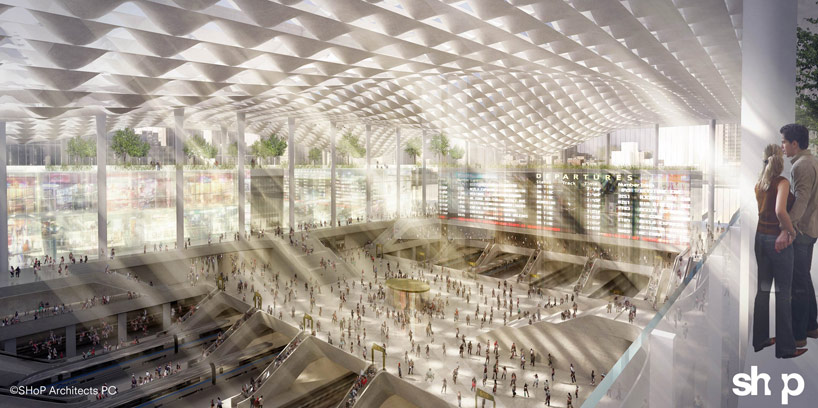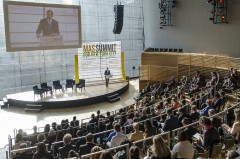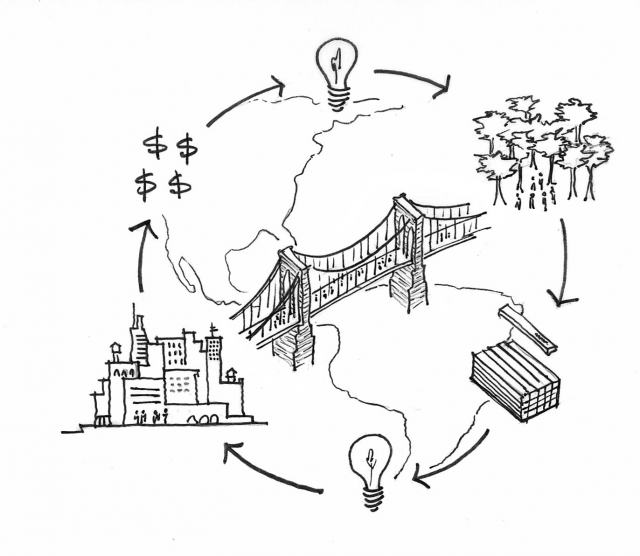
What comes to mind when you think about the coming years in New York City? Resilience? Livability? Community? More new tools for a sharing economy?
In late October, Municipal Art Society held their annual Summit for New York City, exploring the complex challenges that face our city, and cities around the globe, and the leadership and innovation that can drive us forward.
We’ve put together some of the ideas that we found to be the most interesting and exciting from the conference, but should you like to watch it all, video can be found here….
Economics, development, and entrepreneurship
The first day of the summit explored development in New York City with talks ranging from the global place of the city, to the entrepreneurs that are changing the way we earn money.
The Global Perspective
When Greg Clark, a man who has made a name for himself as an advisor to international cities, compared New York with other leading cities around the globe, several interesting themes emerged. According to the measures of McKinsey Global Institute New York remains at the top internationally, but on a closer look we see that while the city excels in diversity, business and fashion, it struggles with cost of living, sustainability, and quality of life.

Clark argues that the problems the city faces have stemmed from its success. He is a strong optimist with great faith in the future of the city, but believes that in order to remain a global urban leader, New York needs to focus on securing funding for long-term priorities. His recommendations for the future include focusing on regional connectivity, affordability and educational attainment.
Penn Station
On a local note, the iconic landmark of Penn Station needs to be redeveloped to meet the needs of a growing population and Madison Square Garden (MSQ) may soon need to find a new home. The discussion comes at a unique time with mayor-elect Bill de Blasio and the federal government both showing interest. However, one of the largest obstacles to building a new station remains – funding. As Marvin Markus from Goldman Sachs stated, “rational users can’t afford to pay it.”
On the development side, Midtown West was discussed by many of the large real estate players in the city. Throughout the day ideas were explored as to possible designs for the new station, where MSQ could be relocated, and the role of the High Line and other open spaces in complementing these new developments.
Technology, entrepreneurship & the sharing economy
Outside of the large-scale development projects, entrepreneurs are transforming our city, one person at a time. Airbnb took the sharing economy to a new level when they launched their online marketplace, allowing people in places around the globe to rent out rooms or their entire apartment, home, or even castle to visitors and tourists. Molly Turner, Airbnb’s Director of Public Policy, looks at their model as a tool to maximize the efficiency of existing resources – instead of staying at a hotel and visiting only tourist destinations travelers can opt to stay in a home that requires little to no additional resources (to build or maintain) and encourages travel in the neighborhoods where natives eat, work and play. Another great benefit comes in times of hardship and disaster. After Hurricane Sandy over 1,400 homes were opened up (for free) to house displaced people.
This type of technology and innovation is driving our future. Etsy, a site most of us know of as an online marketplace for buying and selling hand-crafted products, can also be seen as a hub for entrepreneurship and women’s empowerment. Of the 19,000 sellers in NYC almost all are women and sole-proprietors, and many use the site to supplement or provide all of their income. Althea Erickson, the Director of Policy for Etsy, expressed excitement about the possibilities of expanding this model.
The Nature of Cities
On Friday afternoon, the summit’s focus shifted to urban ecology and the myriad of natural resources that exist within our city that many New Yorkers are unaware of, as well as the far-away resources that keep our city running and which we often take for granted.
Brooklyn Bridge Forest

The Brooklyn Bridge is one of New York’s most iconic landmarks, built from stone, steel, and the wooden pedestrian deck. Scott Francisco from Pilot Projects explained that as the wooden walkway ages and needs to be replaced, it creates an opportunity to link this architectural landmark to rainforest conservation.
In partnership with the Maya Biosphere Reserve in Guatemala the goal is to replace the walkway slat by slat on an as-needed basis, ensuring time to engage the best practices of sustainable forestry. This presentation made us think critically about the role that source forests across the globe continue to have in the infrastructure of our city.
Post-Sandy Rebuilding
We’ve talked about development, entrepreneurship and sustainable resources, but this all lies within the context of a post Hurricane Sandy NYC. Eric Klinenberg, an NYU professor and a leader of Post-Hurricane Sandy research, sees this as “a unique and extraordinary moment to change the way we relate to the environment.” Klinenberg, as a part of the Rebuild by Design team is researching the region to gain a deeper understanding of the impacts of Hurricane Sandy on different communities throughout New York, New Jersey and Connecticut.
Next steps? Rebuild by Design is unveiling their initial ideas, reaching out to the public, and identifying stakeholders and potential funders who can help to carry out their innovative ideas for creating more resilient communities in NYC and the surrounding region. You can explore the projects and add your feedback here, and City Atlas will have more on the Rebuild by Design initiative in coming weeks.
Also happening now and through November 23rd, the Talking Transition project, with a tent on Canal Street and 6th Avenue as well as outreach teams now roaming the city, is providing an innovative public-facing summit on ideas for the next mayoral administration. (Follow the project on Twitter.)
Contributors: Jocelyn Dupre, Nicholas MacDonald and Pamela Soto